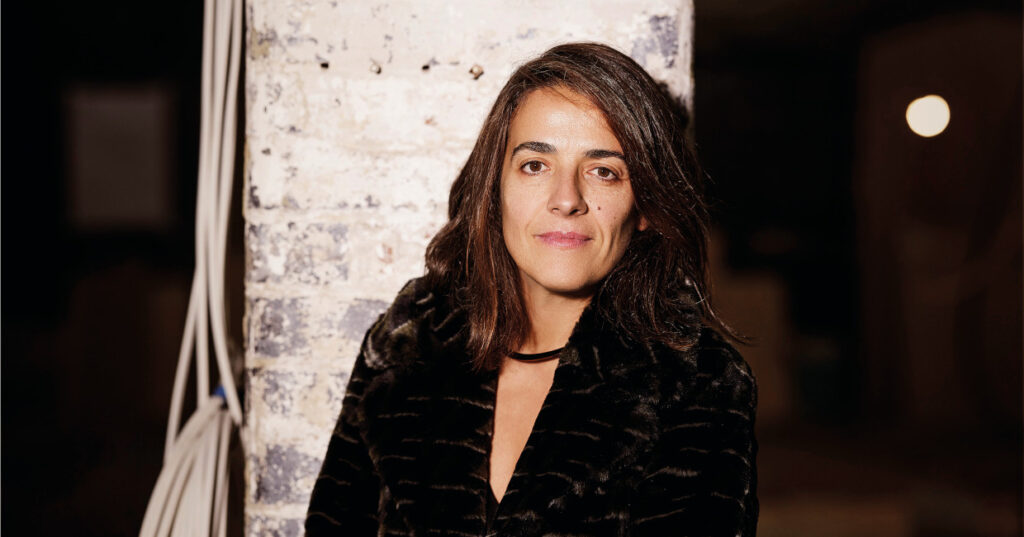Afroditi Krassa launched her own design studio in 2004 and hit the ground running, and she doesn’t seem to have slowed down since! She sat down with Vicky Doe to share how she has curated such success and how her journey has taken her from industrial design to luxury hospitality.
Having trained as a product designer, and spending her early working years at what she refers to as ‘hardcore industrial design agencies’, Afroditi Krassa is now a well-known and respected interior designer with a passion for F&B creations. When we met, and she began to tell me about her background, I couldn’t help but feel in awe of her hugely significant achievements and at how much she has packed into her professional career.
Her route into the field of hospitality design was not the traditional one. She told me: “I’m a trained product designer, so I come from a slightly different perspective than most people in the industry. I was born in London but grew up in Greece and I came back to the UK to study product design. I did my first degree at Central Saint Martin’s London and then went on work for industrial design agencies where the work was based around a lot of electrical and automotive products. I was employed by the largest company at the time called Seymour Powell, who completed industrial designs across the world.”
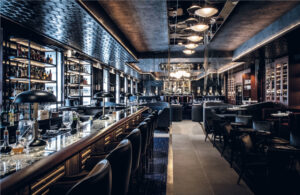
As the first female designer to be employed by the studio in the late 1990s, she was finding her way in, what was then a ‘men’s world’ – designing motorbikes, cars, planes, and mobile phones. She worked with some big names in the industry – Nokia and Jaguar to name a few – and she explained that a great deal of the design process was about understanding the brand, who they are and where they sit in the marketplace. She also needed to understand the technical aspect of design and the process of taking a product and placing it in to mass production.
This experience inspired a change in direction and she went on to complete a Masters degree at the Royal College of Art, specialising in furniture design and moving into a more craft-based world. It was at this point she set up Afroditi – the studio that would later bring her so much success. She explained: “Initially, I was very much pursuing a product design career where we were designing products for manufacturers globally. The big shift for me happened in 2004, when I met the founder of Pret a Manger, Julian Metcalfe.”
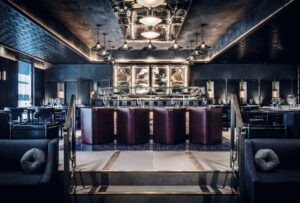
This meeting would go on to have a profound effect on Afroditi and she was given the opportunity to create branding for what later became the food chain, ITSU. She said: “I had never designed a graphic or a piece of branding, ever! It was completely new to me, and I had eight weeks to prove what I could do. Along with his creative vision, I created what became the initial world of ITSU – the whole brand identity, the logo types, the packaging, the uniforms, and the interiors of the first site.”
It was this experience that led her to affinity with the hospitality design industry, she said: “I literally fell in love with the industry: the industry of food; the industry of dealing with people who go out to consume food; the speed of how things were happening; the dynamics of that world and the passion that drives a lot of the people in the industry. And then I decided that this is pretty much my calling!”
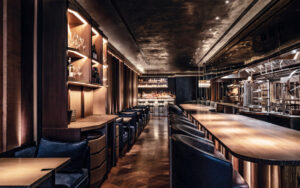
The process was then repeated with the Indian chain Dishoom and Afroditi worked in a very similar way to create another new brand identity and a whole concept for the company. She continued: “And, as they say, the rest is history! There was then an influx of new clients asking us to do the exact same exercise. Whether it was restaurateurs, whether it was start-ups, whether it was hotel groups, we created interest in what we were doing.”
2010 was a pivotal point for Afroditi, and for the studio – the showroom was launched and at this point she realised that this was absolutely the right avenue for her to explore further. The business began to grow, and this allowed her to take on more and more projects on increasingly bigger scales. But the focus was always on F&B.
With 13 staff members now working alongside her, Afroditi does not plan to increase the team by too much more. She explained: “We have had a slow and organic growth and I don’t envision that we will ever become a massive design studio, I think we will always remain on the smaller, niche scale.” Along with the two other directors in the business, she made this conscious decision to ensure that maintaining creative involvement in design remains a high priority. “We want to be working on the best of the best of projects and the scale allows us to do that, to be able to really choose from the best projects out there in the industry.”
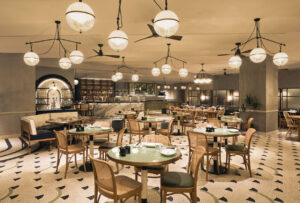
I was intrigued to find out whether Afroditi has favourites among the many, many projects she has created: “To me, the projects that we’re currently working on are always the most exciting because they’re happening as we speak. We can shape them and change them, and we can create new ideas with them. Everything that has launched has been a labour of love. We are a studio where every single person loves design – we are very much driven by passion and emotion in our work, and I think that shows in the end result.
“There’s no project that we haven’t loved working on, no matter how difficult or complicated. Every single project has helped me to grow as a designer, helped my team to grow as people and helped the clients to grow as businesses too.”
Afroditi and her team have worked on brand new concepts but also have completed redesign projects, such as The Savoy Grill. I was interested to know if she and her team felt the same kind of passion for these projects and experienced the same growth. Afroditi explained: “The Savoy Grill is a massively successful project already, by definition, it’s The Savoy Grill! We didn’t create it from scratch, but we were tasked with giving it a new lease of life and continuing the success story for the next 10 or 20 years. It had to run with a design that we created, so the work that we do is always helping businesses grow. It’s very exciting to see our clients grow, as well as us growing alongside them.”
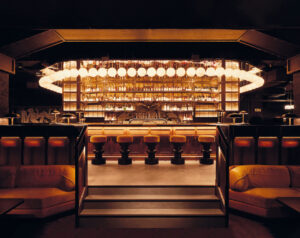
I wondered if the team found it easier to create a concept from scratch or to fulfil a redesign, Afroditi smiled, and said that creating from scratch is where the strength of the company lies. The team, of course, enjoy redesign projects, but the passion is in the creation of something completely new. “Our uniqueness as an agency is that we can concept ideas from zero when there’s nothing in place. We work with hotel groups who ask us to come up with the whole idea of what the restaurant or bar will be. They ask us, ‘What should we be serving there? What will be the name and identity of the space? What will make it unique?’ We have an ability that not many companies globally have – our work across the world allows us to understand how to create concepts that can really resonate with today’s consumer.”
So, does the studio get involved with menu design and creation too? Afroditi told me: “With some of the projects, we create the menu together with the gastronomic teams. We are currently working with Harrods, which is a great client to have, and we’re working side by side with the gastronomy and mixology teams in defining what the offering will be. This means that we can help them shape their creative vision and vice-versa. The response from the chefs and the mixologist helps us to create a narrative for the brand and the interior that goes hand in hand with what they’re offering.” This team approach is even in place where the functionality is established, she told me about the process with Lucky Cat in Mayfair – Gordon Ramsay’s team already had a direction in place for the menu, but the studio helped to define and distil that. This allows everything to connect – from the menu to the interiors, to the lighting, sounds and smell.
With so much to consider when creating a concept for an F&B project, does she take influence from the location? Absolutely! She explained: “We are currently working across very diverse locations from the coastline of Denmark, all the way to the Maldives, as well as in London, the Greek islands, the Americas and we’re just about to start some work in Thailand. A lot of them are with hotel groups in the ultra-luxury and luxury sector so the location is critical in connecting with the design.”
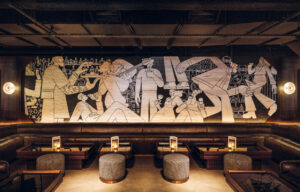
But, she explained, it is just as important to know the users of the space you are designing. “When you have a restaurant opening in Chicago, it’s very different to a restaurant within a resort in the Maldives, and you’re targeting a completely different market with completely different needs. So, you need to consider completely different elements as a designer and as a creative. One of the things we always do before we even start a new project is in-depth research. A lot of designers start immediately on the creative, we always have an initial analysis of the location and of the category that we’re working in to really understand and immerse ourselves in that before we even start on the creative process.”
With such a range of projects completed across different hospitality sectors, I was keen to know from Afroditi how the design process differs between creating concepts for standalone restaurants and those spaces within hotel buildings. She gave this some thought, then said: “Within a hotel F&B project, designs can be a lot more personality driven. Guests almost expect something more theatrical or emotional. It’s a lot more sociable and dynamic than other spaces in the hotel – it’s a different mindset to guestrooms or other spaces in the building. This is different in standalone restaurants which always compete with the hotel restaurants. These often need to be louder or catchier as they need to attract the customer into the space. They need to be expressive. But again, you need to know the customer and their needs. Consider how to engage with them so that the environment can match that.”
With such a focus on the end user, I was keen to find out how Afroditi and her team tackle issues of sustainability in design, which can impact a guest’s decision-making. She explained: “It would really vary depending on the project as some clients have a specific approach to sustainability as a brand, but one of the things we always implement across any project is to really respect and celebrate the given location, building or space. If there are beautiful features within a building, we keep them and design the space to incorporate them. As we work on projects in many different locations we try and use local supply chains and look for smaller local artisans that bring unique craftsmanship to the project.”
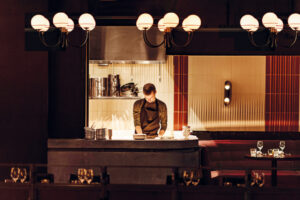
Finally, I asked about the other venture the studio is working on – Akollection, the signature collection of products by Afroditi. She explained: “This began because of my product design roots. In the future we want to expand it into a signature product range that lives in the spaces we design. The current range explores processes and materials that are traditional and artisanal, such as lustrous bevelled glass panels and encaustic cement tiles re-imagined in sleek patterns and unconventional applications.” Under the concept of Urban Opulence, the range of interior products champion a return to sophisticated, bold materials and forms.
It is evident that Afroditi has ambitions for the future of the studio and this stretches beyond interior design. She, and her team, are creating brands and experiences to last.


